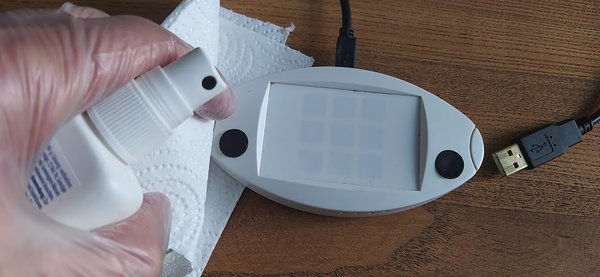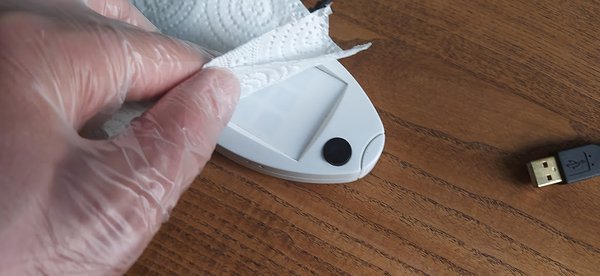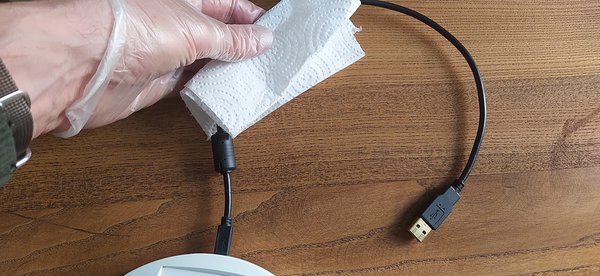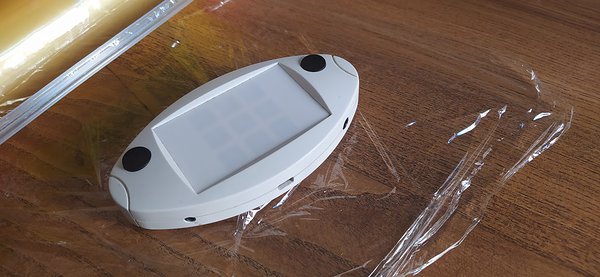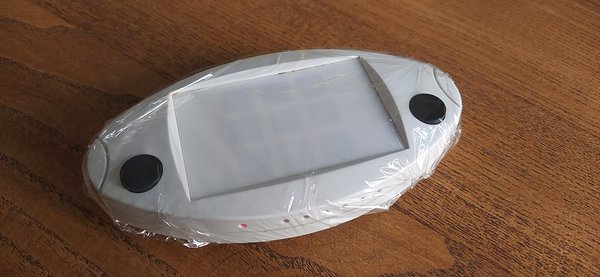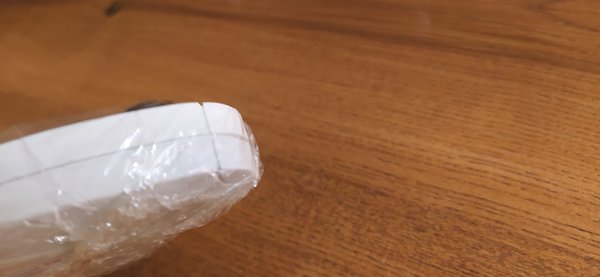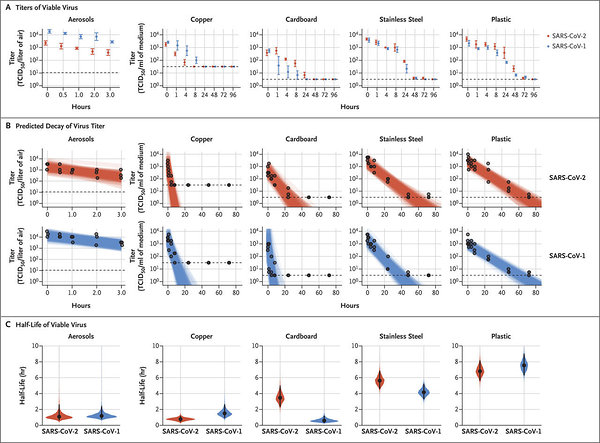Disinfecting QIKtest Device
Hygiene is more important than ever to prevent transmission of viral diseases.
COVID-19 may be active for up to three days on plastic (1) (2). The outer shell of the QIKtest device is plastic. Please follow these instructions for disinfection.
Click images to view in large
Materials needed:
- Disinfection solution or spray
- Paper towels: single-use, kitchen paper
or single-use disinfectant wipes - Gloves: vinyl or latex, single-use
Cleaning the QIKtest Device
How often? After every use.
Wipe down all surfaces and cable of the QIKtest device. Use gloves.
As a precaution, do not spray the device directly or pour solution into or onto buttons/display/plugs and other openings of the plastic case - wipe!
Clean table area/workspace, or put a paper towel beneath beforehand.
After cleaning, discard gloves and paper towels.
Kitchen Foil / Ceran Wrap Method for QIKtest Device:
Load the test settings from PC to the QIKtest device using the USB cable.
Wrap the QIKtest device in thin clear plastic foil.
Hand the wrapped device to the client, run test.
Remove plastic foil after every use, using single-use gloves.
Crumple touched side of foil to the inside, then discard gloves and plastic foil.
Tips on Disinfecting your (Neurofeedback) Practice:
Use disinfectant solution/spray or disinfectant single-use wipes to clean all surfaces: chairs, armrests of chairs, keyboards, mouses, doorhandles, QIKtest device, QIKtest cable, pens handled by patients, smartphones, fixed-line phones including cradle, desktop surface.
- disinfect multiple times daily or/and after every client visit
- use gloves when attaching electrodes during neurofeedback session to clients/patients, wipe down electrodes AND cables, headphones, blindfolds, Neuroamp
- use gloves during complete session
- also: microwave buttons, faucet handles, toilet
- offer hand sanitizer to your clients
- don't cross-contaminate kitchen with other cleaning materials - prefer single-use
- post hand-washing signs at multiple places to remind workers and clients
You are going to need plenty of gloves.
Stay healthy, safe, clean and sane.
=========================================
References Ahttps://www.nejm.org/doi/full/10.1056/NEJMc2004973
Aerosol and Surface Stability of SARS-CoV-2 as Compared with SARS-CoV-1
March 17, 2020DOI: 10.1056/NEJMc2004973
Figure 1. Viability of SARS-CoV-1 and SARS-CoV-2 in Aerosols and on Various Surfaces.
===================================
References B(1)
https://medicalxpress.com/news/2020-03-coronavirus-days-plastic-complicated.html
When the scientists placed virus-laden droplets on plastic, they found that half of the virus was gone after about seven hours. Half of what remained was gone after another seven hours, and so on. By the end of Day Two, there was less than 1/100 of the original amount, and after three days the remnants were barely detectable.
(2)
N van Doremalen, et al. Aerosol and surface stability of HCoV-19 (SARS-CoV-2) compared to SARS-CoV-1. The New England Journal of Medicine. DOI: 10.1056/NEJMc2004973 (2020).
https://www.sciencedaily.com/releases/2020/03/200317150116.htm
https://www.nih.gov/news-events/news-releases/new-coronavirus-stable-hours-surfaces
...
The study was coauthored by scientists at the National Institutes of Health, the Centers of Disease Control and Prevention, UCLA and Princeton University. It was made available in print form on Monday, and aims to provide more clarity on the virus’s contagiousness.
...
The scientists found that SARS-CoV-2, the virus that causes COVID-19, was detectable in the air for up to three hours, up to four hours on copper, up to 24 hours on cardboard, and up to 2 to 3 days on plastic and stainless steel.
...
Source: https://www.marketwatch.com/story/coronavirus-can-survive-up-to-3-hours-in-aerosols-and-up-to-3-days-on-some-surfaces-peer-reviewed-study-finds-2020-03-18?mod=brexit(3)
Sciencedirect, Journal of Hospital Infection 31 January 2020
https://www.fondazionerubestriva.info/public/CI_IN/Persistence%20of%20coronavirus.pdf
Review Persistence of coronaviruses on inanimate surfaces and their inactivation with biocidal agents G. Kampf a, *, D. Todt b , S. Pfaender b , E. Steinmann b aUniversity Medicine Greifswald, Institute for Hygiene and Environmental Medicine, Ferdinand-Sauerbruch-Straße, 17475 Greifswald, Germany
SUMMARY
Currently, the emergence of a novel human coronavirus, SARS-CoV-2, has become a global health concern causing severe respiratory tract infections in humans. Human-to-human transmissions have been described with incubation times between 2-10 days, facilitating its spread via droplets, contaminated hands or surfaces. We therefore reviewed the literature on all available information about the persistence of human and veterinary coronaviruses on inanimate surfaces as well as inactivation strategies with biocidal agents used for chemical disinfection, e.g. in healthcare facilities. The analysis of 22 studies reveals that human coronaviruses such as Severe Acute Respiratory Syndrome (SARS) coronavirus, Middle East Respiratory Syndrome (MERS) coronavirus or endemic human coronaviruses (HCoV) can persist on inanimate surfaces like metal, glass or plastic for up to 9 days, but can be efficiently inactivated by surface disinfection procedures with 62e71% ethanol, 0.5% hydrogen peroxide or 0.1% sodium hypochlorite within 1 minute. Other biocidal agents such as 0.05e0.2% benzalkonium chloride or 0.02% chlorhexidine digluc-onate are less effective. As no specific therapies are available for SARS-CoV-2, early containment and prevention of further spread will be crucial to stop the ongoing outbreak and to control this novel infectious thread.

